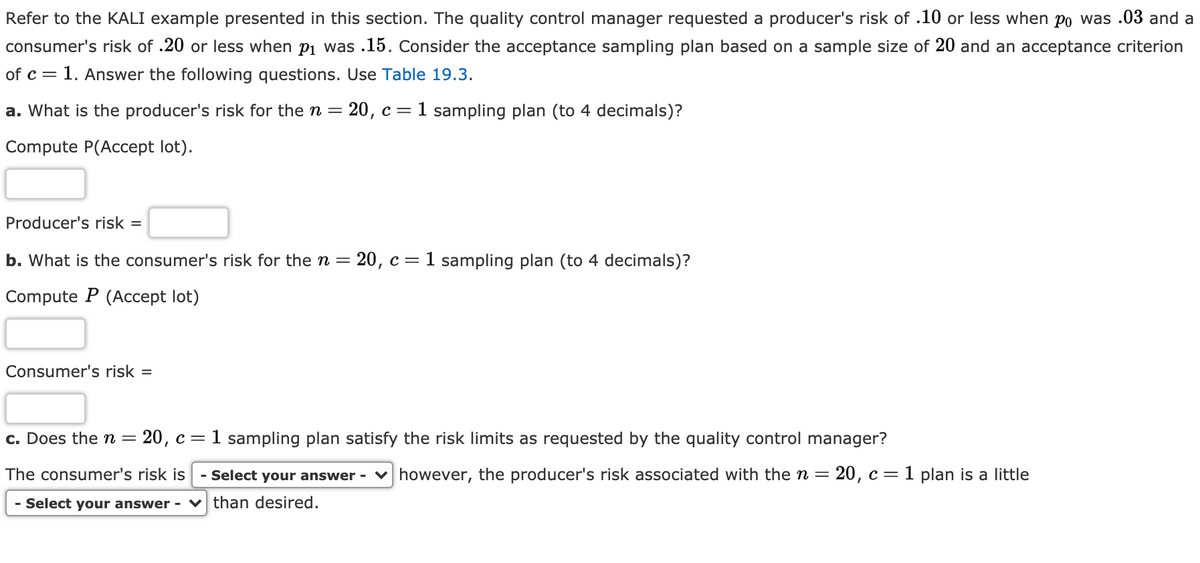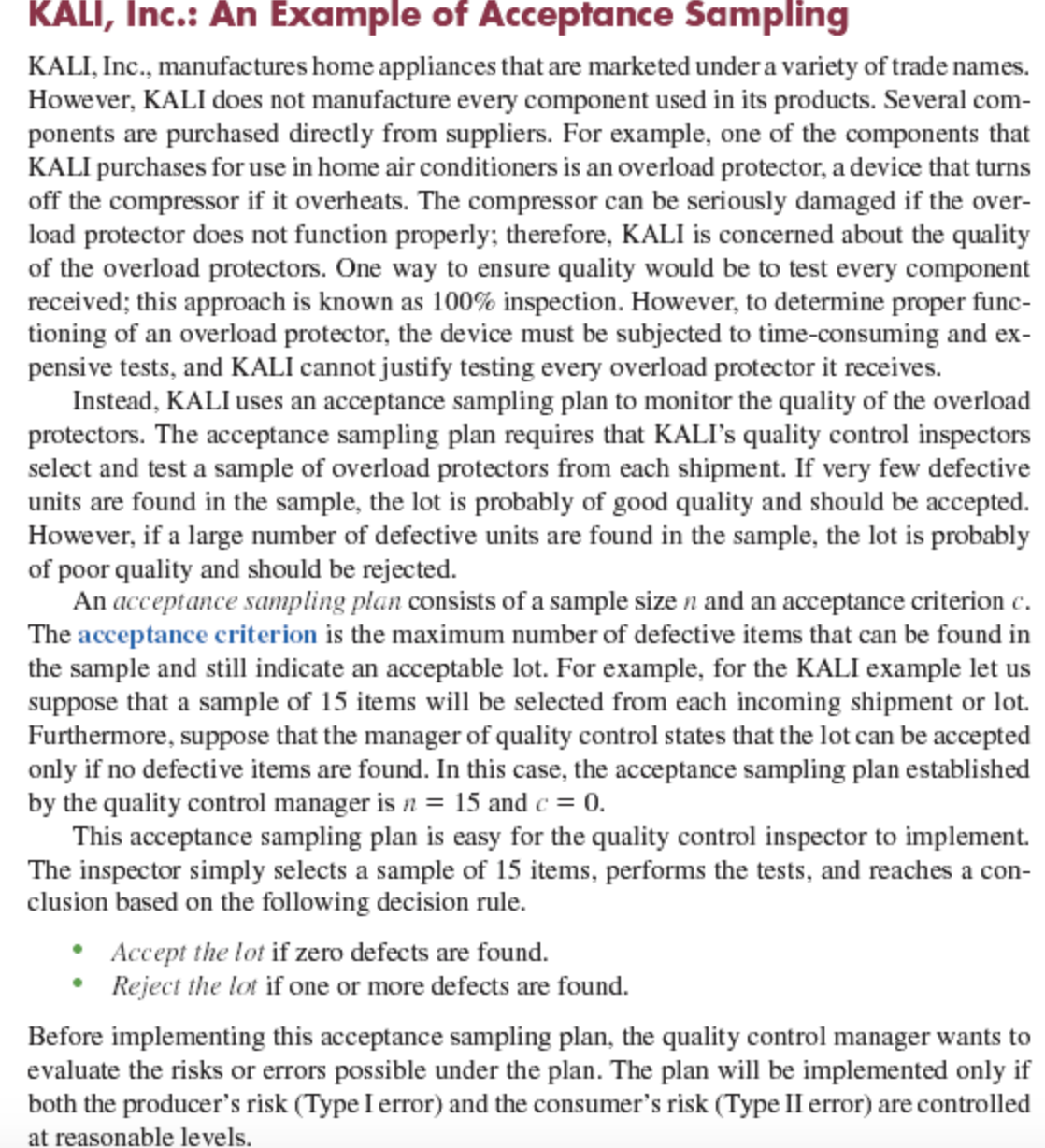Refer to the KALI example presented in this section. The quality control manager requested a producer's risk of .10 or less when po was .03 and consumer's risk of .20 or less when pi was .15. Consider the acceptance sampling plan based on a sample size of 20 and an acceptance criterion of c = 1. Answer the following questions. Use Table 19.3. a. What is the producer's risk for the n = 20, c=1 sampling plan (to 4 decimals)? Compute P(Accept lot). Producer's risk = b. What is the consumer's risk for the n = 20, c=1 sampling plan (to 4 decimals)? Compute P (Accept lot) Consumer's risk = c. Does the n = 20, c= 1 sampling plan satisfy the risk limits as requested by the quality control manager? The consumer's risk is - Select your answer - v however, the producer's risk associated with the n = 20, c =1 plan is a little - Select your answer - v than desired.
Refer to the KALI example presented in this section. The quality control manager requested a producer's risk of .10 or less when po was .03 and consumer's risk of .20 or less when pi was .15. Consider the acceptance sampling plan based on a sample size of 20 and an acceptance criterion of c = 1. Answer the following questions. Use Table 19.3. a. What is the producer's risk for the n = 20, c=1 sampling plan (to 4 decimals)? Compute P(Accept lot). Producer's risk = b. What is the consumer's risk for the n = 20, c=1 sampling plan (to 4 decimals)? Compute P (Accept lot) Consumer's risk = c. Does the n = 20, c= 1 sampling plan satisfy the risk limits as requested by the quality control manager? The consumer's risk is - Select your answer - v however, the producer's risk associated with the n = 20, c =1 plan is a little - Select your answer - v than desired.
Chapter6: Systems Of Equations And Inequalities
Section: Chapter Questions
Problem 17PS: Cholesterol Cholesterol in human blood is necessary, but too much can lead to health problems. There...
Related questions
Topic Video
Question

Transcribed Image Text:Refer to the KALI example presented in this section. The quality control manager requested a producer's risk of .10 or less when po was .03 and a
consumer's risk of .20 or less when p1 was .15. Consider the acceptance sampling plan based on a sample size of 20 and an acceptance criterion
of c =
1. Answer the following questions. Use Table 19.3.
a. What is the producer's risk for the n =
20, с —
1 sampling plan (to 4 decimals)?
Compute P(Accept lot).
Producer's risk =
b. What is the consumer's risk for the n = 20, c=1 sampling plan (to 4 decimals)?
Compute P (Accept lot)
Consumer's risk =
c. Does the n =
20, c=1 sampling plan satisfy the risk limits as requested by the quality control manager?
The consumer's risk is
- Select your answer - v however, the producer's risk associated with then= 20, c= 1 plan is a little
с —
- Select your answer - v than desired.

Transcribed Image Text:KALI, Inc.: An Example of Acceptance Sampling
KALI, Inc., manufactures home appliances that are marketed under a variety of trade names.
However, KALI does not manufacture every component used in its products. Several com-
ponents are purchased directly from suppliers. For example, one of the components that
KALI purchases for use in home air conditioners is an overload protector, a device that turns
off the compressor if it overheats. The compressor can be seriously damaged if the over-
load protector does not function properly; therefore, KALI is concerned about the quality
of the overload protectors. One way to ensure quality would be to test every component
received; this approach is known as 100% inspection. However, to determine proper func-
tioning of an overload protector, the device must be subjected to time-consuming and ex-
pensive tests, and KALI cannot justify testing every overload protector it receives.
Instead, KALI uses an acceptance sampling plan to monitor the quality of the overload
protectors. The acceptance sampling plan requires that KALI's quality control inspectors
select and test a sample of overload protectors from each shipment. If very few defective
units are found in the sample, the lot is probably of good quality and should be accepted.
However, if a large number of defective units are found in the sample, the lot is probably
of poor quality and should be rejected.
An acceptance sampling plan consists of a sample size n and an acceptance criterion c.
The acceptance criterion is the maximum number of defective items that can be found in
the sample and still indicate an acceptable lot. For example, for the KALI example let us
suppose that a sample of 15 items will be selected from each incoming shipment or lot.
Furthermore, suppose that the manager of quality control states that the lot can be accepted
only if no defective items are found. In this case, the acceptance sampling plan established
by the quality control manager is n = 15 and c = 0.
This acceptance sampling plan is easy for the quality control inspector to implement.
The inspector simply selects a sample of 15 items, performs the tests, and reaches a con-
clusion based on the following decision rule.
Accept the lot if zero defects are found.
Reject the lot if one or more defects are found.
Before implementing this acceptance sampling plan, the quality control manager wants to
evaluate the risks or errors possible under the plan. The plan will be implemented only if
both the producer's risk (Type I error) and the consumer's risk (Type II error) are controlled
at reasonable levels.
Expert Solution
This question has been solved!
Explore an expertly crafted, step-by-step solution for a thorough understanding of key concepts.
This is a popular solution!
Trending now
This is a popular solution!
Step by step
Solved in 6 steps

Knowledge Booster
Learn more about
Need a deep-dive on the concept behind this application? Look no further. Learn more about this topic, statistics and related others by exploring similar questions and additional content below.Recommended textbooks for you


Linear Algebra: A Modern Introduction
Algebra
ISBN:
9781285463247
Author:
David Poole
Publisher:
Cengage Learning

Algebra for College Students
Algebra
ISBN:
9781285195780
Author:
Jerome E. Kaufmann, Karen L. Schwitters
Publisher:
Cengage Learning


Linear Algebra: A Modern Introduction
Algebra
ISBN:
9781285463247
Author:
David Poole
Publisher:
Cengage Learning

Algebra for College Students
Algebra
ISBN:
9781285195780
Author:
Jerome E. Kaufmann, Karen L. Schwitters
Publisher:
Cengage Learning

Glencoe Algebra 1, Student Edition, 9780079039897…
Algebra
ISBN:
9780079039897
Author:
Carter
Publisher:
McGraw Hill